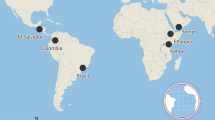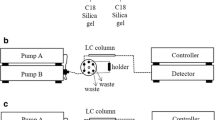Abstract
A salting-out assisted liquid–liquid extraction method followed by high performance liquid chromatography with ultraviolet–visible detector (SALLE-HPLC–UV/Vis) has been proposed for determination of caffeine and nicotinic acid in raw and roasted coffee samples. Various parameters affecting chromatographic separations including mobile phase composition, injection volume, flow rate and column temperature were studied. Experimental parameters affecting the extraction efficiency of SALLE method such as type and volume of the organic solvent, type and amount of salt, pH of the sample, and concentration of the ion-pairing reagent were also studied and thereby optimum conditions were established. The calibration curves which were constructed at five different concentration levels using the optimum conditions exhibited good linearity, with the coefficient of determination (R2) 0.999 and 0.995 for caffeine and nicotinic acid, respectively. The limits of detection (LOD) and quantification (LOQ) which were determined at 3 and 10 times signal-to-noise ratio were 0.05 and 0.13 mg/L for nicotinic acid and 0.20 and 0.63 mg/L for caffeine, respectively. Intra- and inter-day precision studies were demonstrated satisfactory precision with RSD values below 10. Relative recoveries were also studied, and their results were ranging from 82–122% for both raw and roasted coffee samples. The findings demonstrated that the proposed method could be used as an effective and best alternative for the determination of caffeine and nicotinic acid in raw and roasted coffee samples.
Highlights
• SALLE was proposed for extraction caffeine and NA from raw and roasted coffee samples.
• HPLC-UV/Vis was used for separation and determination of the target analytes.
• The method has exhibited satisfactory analytical performance characteristics and good selectivity for both analytes.
• The method uses classical laboratory apparatuses and small volume of less toxic organic solvent.
• Compared to the other methods, the proposed method has similar or better LOD and LOQ than the earlier reported methods.




Similar content being viewed by others
References
Sunarharum WB, Williams DJ, Smyth HE. Complexity of coffee flavor: a compositional and sensory perspective. Food Res Int. 2014;62:315–25. https://doi.org/10.1016/j.foodres.2014.02.030.
Toledo PRAB, Pezza L, Pezza HR, Toci AT. Relationship between the different aspects related to coffee quality and their volatile compounds. Compr Rev Food Sci Food Saf. 2016;15(4):705–19. https://doi.org/10.1111/1541-4337.12205.
Cheng B, Furtado A, Smyth HE, Henry RJ. Influence of genotype and environment on coffee quality. Trends Food Sci Tech. 2016;57(Part A):20–30. https://doi.org/10.1016/j.tifs.2016.09.003.
Casal S, Oliveira MBPP, Alves MR, Ferreira MA. Discriminate analysis of roasted coffee varieties for trigonelline, nicotinic acid, and caffeine content. J Agric Food Chem. 2000;48(8):3420–4. https://doi.org/10.1021/jf990702b.
Liu H, Shao J, Li Q, Li Y, Yan H, He L. Determination of trigonelline, nicotinic acid, and caffeine in Yunnan arabica coffee by microwave-assisted extraction and HPLC with two columns in series. J AOAC Intl. 2012;95(4):1138–41. https://doi.org/10.1021/jf990702b.
Jeszka-Skowron M, Sentkowska A, Pyrzyńska K, De Peña MP. Chlorogenic acids, caffeine content and antioxidant properties of green coffee extracts: influence of green coffee bean preparation. Eur Food Res Technol. 2016;242(8):1403–9. https://doi.org/10.1007/s00217-016-2643-y.
Nuhu AA. Bioactive micronutrients in coffee: recent analytical approaches for characterization and quantification. ISRN Nutr. 2014. https://doi.org/10.1155/2014/384230.
Casas MI, Vaughan MJ, Bonello P, Gardener B, Grotewold E, Alonso AP. Identification of biochemical features of defective Coffea arabica L. beans. Food Res Int. 2017;95:59–67. https://doi.org/10.1016/j.foodres.2017.02.015.
Kraemer K, Semba RD, Eggersdorfer M, Schaumberg DA. Introduction: the diverse and essential biological functions of vitamins. Ann Nutr Metab. 2012;61(3):185–91. https://doi.org/10.1159/000343103.
Dórea JG, da Costa THM. Is coffee a functional food? Br J Nutr. 2005;93(6):773–82. https://doi.org/10.1079/BJN20051370.
Jeszka-Skowron M, Frankowski R, Zgoła-Grześkowiak A. Comparison of methylxanthines, trigonelline, nicotinic acid and nicotinamide contents in brews of green and processed Arabica and Robusta coffee beans–Influence of steaming, decaffeination and roasting processes on coffee beans. LWT-Food Sci Technol. 2020;125:109344. https://doi.org/10.1016/j.lwt.2020.109344.
Caprioli G, Cortese M, Maggi F, Minnetti C, Odello L, Sagratini G, Vittori S. Quantification of caffeine, trigonelline and nicotinic acid in espresso coffee: the influence of espresso machines and coffee cultivars. Int J Food Sci Nutr. 2014;65(4):465–9. https://doi.org/10.3109/09637486.2013.873890.
Dias RCE, Benassi MT. Discrimination between arabica and robusta coffees using hydro-soluble compounds: is the efficiency of the parameters dependent on the roast degree? Beverages. 2015;1(3):127–39. https://doi.org/10.3390/beverages1030127.
Gant A, Leyva VE, Gonzalez AE, Maruenda H. Validated HPLC-diode array detector method for simultaneous evaluation of six quality markers in coffee. J AOAC Intl. 2015;98(1):98–102. https://doi.org/10.5740/jaoacint.14-113.
Casal S, Oliveira MB, Ferreira MA. Development of an HPLC/diode-array detector method for simultaneous determination of trigonelline, nicotinic acid, and caffeine in coffee. J Liq Chrom Rel Technol. 1998;21(20):3187–95. https://doi.org/10.1080/10826079808001267.
Casal S, Oliveira MB, Ferreira MA. HPLC/diode-array applied to the thermal degradation of trigonelline, nicotinic acid and caffeine in coffee. Food Chem. 2000;68(4):481–5. https://doi.org/10.1016/s0308-8146(99)00228-9.
Perrone D, Donangelo CM, Farah A. Fast simultaneous analysis of caffeine, trigonelline, nicotinic acid and sucrose in coffee by liquid chromatography–mass spectrometry. Food Chem. 2008;110(4):1030–5. https://doi.org/10.1016/j.foodchem.2008.03.012.
Rodrigues NP, Bragagnolo N. Identification and quantification of bioactive compounds in coffee brews by HPLC–DAD–MSn. J Food Compos Anal. 2013;32(2):105–15. https://doi.org/10.1016/j.jfca.2013.09.002.
Song HY, Jang HW, Debnath T, Lee KG. Analytical method to detect adulteration of ground roasted coffee. Int J Food Sci Technol. 2019;54(1):256–62. https://doi.org/10.1111/ijfs.13942.
Arai K, Terashima H, Aizawa S, Taga A, Yamamoto A, Tsutsumiuchi K, Kodama S. Simultaneous determination of trigonelline, caffeine, chlorogenic acid, their related compounds in instant coffee samples by HPLC using an acidic mobile phase containing octanesulfonate. Anal Sci. 2015;31(8):831–5. https://doi.org/10.2116/analsci.31.831.
Ciaramelli C, Palmioli A, Airold C. Coffee variety, origin and extraction procedure: implications for coffee beneficial effects on human health. Food Chem. 2019;278:47–55. https://doi.org/10.1016/j.foodchem.2018.11.063.
Itzberger CSG, Scholz MBS, Benassi MT. Bioactive compounds content in roasted coffee from traditional and modern coffea arabica cultivars grown under the same edapho-climatic conditions. Food Res Int. 2014;61:61–6. https://doi.org/10.1016/j.foodres.2014.04.031.
Alshishani A, Salhimi SM, Saad B. Salting-out assisted liquid-liquid extraction coupled with hydrophilic interaction chromatography for the determination of biguanides in biological and environmental samples. J Chromatogr B. 2018;1073:51–9. https://doi.org/10.1016/j.jchromb.2017.12.013.
Gezahegn T, Tegegne B, Zewge F, Chandravansh BS. Salting-out assisted liquid–liquid extraction for the determination of ciprofloxacin residues in water samples by high performance liquid chromatography–diode array detector. BMC Chem. 2019;13:28. https://doi.org/10.1186/s13065-019-0543-5.
Tandel D, Shah P, Patel K, Thakkar V, Patel K, Gandhi T. Salting-out assisted liquid–liquid extraction for quantification of febuxostat in plasma using RP-HPLC and its pharmacokinetic application. J Chromatogr Sci. 2016;54(10):1827–33. https://doi.org/10.1093/chromsci/bmw124.
Sazali NH, Alshishani A, Saad B, Chew KY, Chong MM, Miskam M. Salting-out assisted liquid–liquid extraction coupled with high-performance liquid chromatography for the determination of vitamin D3 in milk samples. Roy Soc Open Sci. 2019;6(8):190952. https://doi.org/10.1098/rsos.190952.
Gure A, Lara FJ, Moreno-Ganzález D, Megersa N, Olmo-Iruela MD, García-Campaña AM. Salting-out assisted liquid–liquid extraction combined with capillary HPLC for the determination of sulfonylurea herbicides in environmental water and banana juice samples. Talanta. 2014;127:51–8. https://doi.org/10.1016/j.talanta.2014.03.070.
Roth J, Peer CJ, Widemann B, Cole DE, Ershler R, Helman L, Schrump D, Figg WD. Quantitative determination of mithramycin in human plasma by a novel, sensitive ultra-HPLC–MS/MS method for clinical pharmacokinetic application. J Chromatogr B. 2014;970:95–101. https://doi.org/10.1016/j.jchromb.2014.08.021.
Ahmed OS, Ladner Y, Montels J, Philibert L, Perrin C. Coupling of salting-out assisted liquid–liquid extraction with on-line stacking for the analysis of tyrosine kinase inhibitors in human plasma by capillary zone electrophoresis. J Chromatogr A. 2018;1579:121–8. https://doi.org/10.1016/j.chroma.2018.10.017.
Myasein F, Kim E, Zhang J, Wu H, El-Shourbagy TA. Rapid, simultaneous determination of lopinavir and ritonavir in human plasma by stacking protein precipitations and salting-out assisted liquid/liquid extraction, and ultrafast LC–MS/MS. Anal Chim Acta. 2009;651(1):112–6. https://doi.org/10.1016/j.aca.2009.08.010.
Hassan J, Bahrani S. Determination of atorvastatin in human serum by salting out assisted solvent extraction and reversed-phase high-performance liquid chromatography–UV detection. Arabian J Chem. 2014;7(1):87–90. https://doi.org/10.1016/j.arabjc.2013.07.057.
Alshishani AA, Saad B, Semail NF, Salhimi SM, Talib MKM. Salting-out assisted liquid-liquid extraction method coupled to gas chromatography for the simultaneous determination of thujones and pulegone in beverages. Int J Food Prop. 2017;20(3):S2776–85. https://doi.org/10.1080/10942912.2017.1373665.
Fan Y, Hu S, Liu S. Salting-out assisted liquid–liquid extraction coupled to dispersive liquid–liquid microextraction for the determination of chlorophenols in wine by high-performance liquid chromatography. J Sep Sci. 2014;37(24):3662–8. https://doi.org/10.1002/jssc.201400869.
Song S, Ediage EN, Wu A, Saege SD. Development and application of salting-out assisted liquid/liquid extraction for multi-mycotoxin biomarkers analysis in pig urine with high performance liquid chromatography/tandem mass spectrometry. J Chromatogr A. 2013;1292:111–20. https://doi.org/10.1016/j.chroma.2012.10.071.
Romero-González RR, Verpoorte R. Salting-out gradients in centrifugal partition chromatography for the isolation of chlorogenic acids from green coffee beans. J Chromatogr A. 2014;1216(19):4245–51. https://doi.org/10.1016/j.chroma.2009.02.007.
Tsai WH, Huang TC, Chen HH, Wu YW, Huang JJ, Chuang HY. Determination of sulfonamides in swine muscle after salting-out assisted liquid extraction with acetonitrile coupled with back-extraction by a water/acetonitrile/dichloromethane ternary component system prior to high-performance liquid chromatography. J Chromatogr A. 2010;1217(3):250–5. https://doi.org/10.1016/j.chroma.2009.11.035.
Razmara R, Daneshfar A, Sahrai R. Determination of methylene blue and sunset yellow in wastewater and food samples using salting out assisted liquid–liquid extraction. J Indus Eng Chem. 2011;17(3):533–6. https://doi.org/10.1016/j.jiec.2010.10.028.
Wang M, Cai Z, Xu L. Coupling of acetonitrile deproteinization and salting-out extraction with acetonitrile stacking in chiral capillary electrophoresis for the determination of warfarin enantiomers. J Chromatogr A. 2011;1218(26):4045–51. https://doi.org/10.1016/j.chroma.2011.04.067.
Wang H, Zhou X, Zhang Y, Chen H, Li G, Xu Y, Zhao Q, Song W, Jin H, Ding L. Dynamic microwave-assisted extraction coupled with salting-out liquid-liquid extraction for determination of steroid hormones in fish tissues. J Agric Food Chem. 2012;60(41):10343–51. https://doi.org/10.1021/jf303124c.
Tang YQ, Weng N. Salting-out assisted liquid–liquid extraction for bioanalysis. Bioanalysis/. 2013;5(12):1583–98. https://doi.org/10.4155/bio.13.117.
Gao S, Wu G, Li X, Chen J, Wu Y, Wang J, Zhang Z. Determination of triazine herbicides in environmental water samples by acetonitrile inorganic salt aqueous two-phase microextraction system. J Anal Test. 2018;2(4):322–31. https://doi.org/10.1007/s41664-018-0073-5.
Liu J, Jiang M, Li G, Xu L, Xie M. Miniaturized salting-out liquid–liquid extraction of sulfonamides from different matrices. Anal Chim Acta. 2010;679(1–2):74–80. https://doi.org/10.1016/j.aca.2010.09.013.
Kukusamude C, Burakham R, Chailapakul O, Srijaranai S. High performance liquid chromatography for the simultaneous analysis of penicillin residues in beef and milk using ion paired extraction and binary water-acetonitrile mixture. Talanta. 2012;92:38–44. https://doi.org/10.1016/j.talanta.2012.01.020.
Fernandes JO, Ferreira MA. Combined ion-pair extraction and gas chromatography-mass spectrometry for the simultaneous determination of diamines, polyamines and aromatic amines in Port wine and grape juice. J Chromatogr A. 2000;886(1–2):183–95. https://doi.org/10.1016/s0021-9673(00)00447-7.
Quesada-Molina C, García-Campaña AM, Olmo-Iruel MD. Ion-paired extraction of cephalosporins in acetone prior to their analysis by capillary liquid chromatography in environmental water and meat samples. Talanta. 2013;115:943–9. https://doi.org/10.1016/j.talanta.2013.07.008.
Acknowledgements
Jimma University Chemistry Department (Jimma, Ethiopia) is greatly acknowledged for providing laboratory facilities and chemicals for this work.
Author information
Authors and Affiliations
Corresponding author
Ethics declarations
Conflict of interest
The authors declare that they have no conflicts of interest.
Electronic supplementary material
Below is the link to the electronic supplementary material.
About this article
Cite this article
Chirfa, G., Merdassa, Y. & Gure, A. Salting-out Assisted Liquid–Liquid Extraction for Analysis of Caffeine and Nicotinic Acid in Coffee by HPLC–UV/Vis Detector. J. Anal. Test. 4, 298–306 (2020). https://doi.org/10.1007/s41664-020-00148-7
Received:
Accepted:
Published:
Issue Date:
DOI: https://doi.org/10.1007/s41664-020-00148-7




